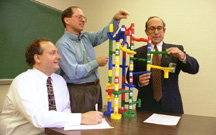 Purdue News
Purdue News
 Purdue News
Purdue News
April 1997

|
The toy is a plastic construction set that rolls marbles down a chute and drops them onto a target. It is just one of many toys and models used in the classroom at the Center for the Management of Manufacturing Enterprises (CMME) in Purdue's School of Management, and in training exercises for the corporations that the center serves.
The idea to use toys to simulate manufacturing came out of a collaboration between Robert D. Plante, professor of management, and Professors Herbert Moskowitz, the Lewis B. Cullman Distinguished Professor of Manufacturing Management and CMME director, and Thomas F. Brady, assistant director. They use the toys for hands-on workshops on quality and productivity improvement.
Plante and Moskowitz had been searching toy stores for a new demonstration tool when Plante discovered the toy.
"I had been looking for a model to use for simulations, and had even considered having one built, when I stumbled over my kid's toys in the basement and began to put this one together," Plante says.
Since August 1995, the CMME team has used the marble toy as a centerpiece in workshops with alumni representing many organizations and management teams from a consumer electronics firm, a construction and agricultural equipment manufacturer, and others. The management teams then use the toy method to train line workers and other employees.
The toy simulates the manufacturing process. The marbles are different shapes, weights and sizes and represent possible variables in an organizational setting such as the skill level of workers, employee work habits, available data, or suppliers and transportation.
During the workshop, teams attempt to make the marbles hit a target by deciding whether or not to adjust the toy or control the speed of the marbles. Once the team finds a method that works most of the time, the team documents and shares the results.
For example, a team working with the marble toy may find that the marble hits the target by making just a small change, or by not adjusting the toy at all. In the workplace, a small change or "no adjustment" decision translates into lower employee stress and higher productivity, because employees are not required to change. Often times, according to the CMME team, the managers in the workshops don't realize the effect of major change on their employees until they see how a major adjustment to the toy can throw the marble off target.
The exercise teaches workers and managers how important it is to know a production process inside and out before making decisions. It also demonstrates the importance of focusing on the process, not the results. The CMME message: If the process is good, the results will be, too.
"The concept of continuous improvement in manufacturing is nothing new, but teaching the men or women on the line to apply scientific processes to their particular task is," Moskowitz says. "We're teaching them to make decisions based on data, not folklore. And the idea of becoming 'manufacturing scientists' can be applied in all areas of an organization. This is a real culture change."
The program has been so successful for one organization, it's expanding. On April 23, the CMME team will conduct a workshop for teams from Latin America, Asia and Europe.
But taking the workshops global isn't going to be easy. The team is planning to work with a consortium of companies and universities from China, Malaysia, France and Thailand. Members of the consortium then will teach the marble toy and other techniques to firms, in their own countries, with international manufacturing operations.
"We need to partner with someone who speaks the language and understands the culture of these countries, " Moskowitz says.
Purdue students also benefit from the toy-training and other creative teaching techniques.
Graduate student Paul Vanderspek, who has worked with the toy model in class, says the exercise is far more effective than reading a case study.
"The toy is an excellent graphic display of what can happen in a workplace when management over-adjusts to market demands or any situation," he says.
The Center for the Management of Manufacturing Enterprises at Purdue, created in 1988, is a partnership between the School of Management, the Schools of Engineering, the School of Technology and key manufacturing enterprises. One of the top three programs of its kind in the nation, its mission is to create and implement educational programs, conduct research and facilitate networking activities that contribute to and enhance our nation's competitiveness.
Sources: Herbert Moskowitz, (765) 494-4421; e-mail, herbm@mgmt.purdue.edu
Robert Plante, (765) 494-4464; e-mail, bob@mgmt.purdue.edu
Writer: Kate Walker, (765) 494-2073; e-mail, kate_walker@purdue.edu
Purdue News Service: (765) 494-2096; e-mail, purduenews@purdue.edu
Photo caption:
Color photo, electronic transmission, and Web and ftp download available. Photo ID:
Moskowitz.Toy
Download here.